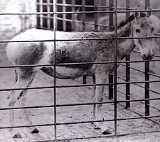
Syrian Wild Ass
Encyclopedia
The Syrian Wild Ass is an extinct subspecies of Equus hemionus that ranged across Syria
, Jordan
and Iraq
.
The Syrian Wild Ass was the smallest form of Equidae
and could not be domesticated. Its coloring changed with the seasons—a tawny olive coat for the summer months and pale sandy yellow for the winter.
It is believed this is the animal described as the "wild ass" in several books of the Old Testament
, including Job
, Psalms
, Jeremiah
and the Apochryphal book of Sirach
. European travelers in the Middle East during the 15th and 16th centuries reported seeing large herds. However, its numbers began to drop precipitously during the 18th and 19th centuries due to overhunting, and its existence was further imperiled by the regional upheaval of World War I
. The last known wild specimen was fatally shot in 1927 at Al Ghams near the Azraq oasis in Jordan, and the last captive specimen died the same year at the Vienna Zoo.
Syria
Syria , officially the Syrian Arab Republic , is a country in Western Asia, bordering Lebanon and the Mediterranean Sea to the West, Turkey to the north, Iraq to the east, Jordan to the south, and Israel to the southwest....
, Jordan
Jordan
Jordan , officially the Hashemite Kingdom of Jordan , Al-Mamlaka al-Urduniyya al-Hashemiyya) is a kingdom on the East Bank of the River Jordan. The country borders Saudi Arabia to the east and south-east, Iraq to the north-east, Syria to the north and the West Bank and Israel to the west, sharing...
and Iraq
Iraq
Iraq ; officially the Republic of Iraq is a country in Western Asia spanning most of the northwestern end of the Zagros mountain range, the eastern part of the Syrian Desert and the northern part of the Arabian Desert....
.
The Syrian Wild Ass was the smallest form of Equidae
Equidae
Equidae is the taxonomic family of horses and related animals, including the extant horses, donkeys, and zebras, and many other species known only from fossils. All extant species are in the genus Equus...
and could not be domesticated. Its coloring changed with the seasons—a tawny olive coat for the summer months and pale sandy yellow for the winter.
It is believed this is the animal described as the "wild ass" in several books of the Old Testament
Old Testament
The Old Testament, of which Christians hold different views, is a Christian term for the religious writings of ancient Israel held sacred and inspired by Christians which overlaps with the 24-book canon of the Masoretic Text of Judaism...
, including Job
Book of Job
The Book of Job , commonly referred to simply as Job, is one of the books of the Hebrew Bible. It relates the story of Job, his trials at the hands of Satan, his discussions with friends on the origins and nature of his suffering, his challenge to God, and finally a response from God. The book is a...
, Psalms
Psalms
The Book of Psalms , commonly referred to simply as Psalms, is a book of the Hebrew Bible and the Christian Bible...
, Jeremiah
Jeremiah
Jeremiah Hebrew:יִרְמְיָה , Modern Hebrew:Yirməyāhū, IPA: jirməˈjaːhu, Tiberian:Yirmĭyahu, Greek:Ἰερεμίας), meaning "Yahweh exalts", or called the "Weeping prophet" was one of the main prophets of the Hebrew Bible...
and the Apochryphal book of Sirach
Sirach
The Book of the All-Virtuous Wisdom of Jesus ben Sira , commonly called the Wisdom of Sirach or simply Sirach, and also known as Ecclesiasticus or Siracides , is a work from the early 2nd century B.C. written by the Jewish scribe Jesus ben Sirach of Jerusalem...
. European travelers in the Middle East during the 15th and 16th centuries reported seeing large herds. However, its numbers began to drop precipitously during the 18th and 19th centuries due to overhunting, and its existence was further imperiled by the regional upheaval of World War I
World War I
World War I , which was predominantly called the World War or the Great War from its occurrence until 1939, and the First World War or World War I thereafter, was a major war centred in Europe that began on 28 July 1914 and lasted until 11 November 1918...
. The last known wild specimen was fatally shot in 1927 at Al Ghams near the Azraq oasis in Jordan, and the last captive specimen died the same year at the Vienna Zoo.

